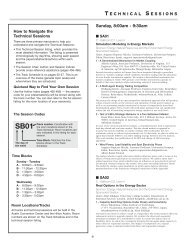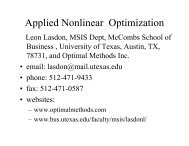Sunday
Sunday
Sunday
You also want an ePaper? Increase the reach of your titles
YUMPU automatically turns print PDFs into web optimized ePapers that Google loves.
SA37<br />
■ SA37<br />
37- North 226 A- CC<br />
Revenue Management and Pricing in Practice<br />
Sponsor: Revenue Management & Pricing<br />
Sponsored Session<br />
Chair: Tugrul Sanli, Director, R&D, SAS Institute Inc.,<br />
SAS Campus Drive, Cary, NC, 27513, United States of America,<br />
Tugrul.Sanli@sas.com<br />
1 - Randomized Linear Programming Approach to Revenue<br />
Management<br />
Vijay Desai, Opertations Research Specialist, SAS Institute Inc.,<br />
SAS Campus Dr, Cary, NC, 27513, United States of America,<br />
VijayV.Desai@sas.com, Altan Gulcu<br />
We provide a high-level overview of our approach to RM using RLP. Following<br />
are the key features of our methodology: a) Pricing of price-dependent products.<br />
b) Handles network-level overbooking as opposed to resource-level overbooking<br />
typically found in practice. c) Allows for imposition of service level constraints. d)<br />
Computes ancillary outputs such as occupancy forecast, revenue forecast and<br />
service levels, which are useful metrics for a revenue manager.<br />
2 - Dynamic Pricing and Revenue Management<br />
Maarten Oosten, SAS Institute, World Headquarters,<br />
SAS Campus Drive, Cary, NC, 27513, United States of America,<br />
maarten.oosten@sas.com<br />
New technologies allow for pricies to be changed continuously, and optimal<br />
dynamic pricing algorithms take this freedom explicitly into account. In this<br />
presentation we explore several directions in which this can be taken.<br />
3 - Estimation of Nested Logit Models using Data from a Single<br />
Firm<br />
Jeff Newman, Research Engineer, Georgia Institute of Technology,<br />
790 Atlantic Drive, Civil Engineering, Atlanta, GA, 30332,<br />
United States of America, jeff@newman.me, Laurie Garrow,<br />
Mark Ferguson<br />
We examine identification issues for estimating parameters for discrete choice<br />
models with censored data. Most work in revenue management using such<br />
models has been focused on simple multinomial logit models, because the unique<br />
IIA property of this model makes estimating and applying parameters convenient.<br />
However, IIA is not usually consistent with actual choice behaviors. We examine<br />
the benefits and drawbacks of employing a nested logit model, which does not<br />
exhibit IIA.<br />
4 - Improving the Forecasting Accuracy of Hotel Arrivals:<br />
A New Non-homogeneous Poisson Approach<br />
Misuk Lee, IHG, 3 Ravinia Drive, Atlanta, GA, 30327,<br />
United States of America, Misuk.Lee@ihg.com<br />
Demand forecast is one of key components of hotel revenue management. This<br />
study develops a new non-homogenous Poisson process approach to short-term<br />
demand forecast. By considering seasonality and heterogeneous booking curve<br />
patterns, we find better estimates for demand processes and thus improve<br />
forecasting accuracy. We present validation results on IHG hotel data along with a<br />
comparison to other benchmark models.<br />
■ SA38<br />
38- North 226 B- CC<br />
Impact of Customer Behavior on Service<br />
Sponsor: Service Science<br />
Sponsored Session<br />
Chair: Margaret Pierson, Assistant Professor, Tuck at Dartmouth,<br />
Hanover, NH, United States of America, mpierson@hbs.edu<br />
1 - How Do Customers Respond to Service Quality Competition?<br />
Ryan Buell, Assistant Professor, Harvard Business School,<br />
Morgan Hall T37, Boston, MA, 02163, United States of America,<br />
rbuell@hbs.edu, Dennis Campbell, Frances Frei<br />
When does increased service quality competition lead to customer defection, and<br />
which customers are most likely to defect? We find that customers defect at a<br />
higher rate from the incumbent following increased service quality (price)<br />
competition when the incumbent offers high (low) quality service relative to<br />
existing competitors in a local market. We further show that it is the high quality<br />
incumbent’s most profitable customers who are the most attracted by superior<br />
quality entrants.<br />
INFORMS Phoenix – 2012<br />
68<br />
2 - Modeling Customer Behavior in Multichannel Customer<br />
Support Services: An Information Stock Approach<br />
Serguei Netessine, Professor, INSEAD, Boulevard de Constance,<br />
Fountainbleau, 77305, France, Serguei.Netessine@insead.edu,<br />
Kinshuk Jerath, Anuj Kumar<br />
We analyze multichannel customer support environment of a health insurance<br />
firm in the US. We build a structural probability model to understand the<br />
customers’ query arrival and channel choice processes. Our estimates suggest the<br />
telephone channel in our setting on average provides 20 times more information<br />
than the Web channel and that the Web on average provides information need<br />
instead of information gain – Web in our setting seems to confuse customers.<br />
3 - Customer Response to Short-Term Price Fluctuations<br />
Margaret Pierson, Assistant Professor, Tuck at Dartmouth,<br />
Hanover, NH, United States of America, mpierson@hbs.edu<br />
Transactions at 15 gasoline stations in Massachusetts over two years are used to<br />
estimate consumer elasticity with respect to price on a transaction basis. A<br />
significant proportion of the observed transactions display high sensitivity to<br />
price. This customer behavior results in congestion at pumps during high prices, a<br />
counterintuitive result which constrains stations’ price choices in practice.<br />
■ SA39<br />
39- North 226 C- CC<br />
Service Scripting and Value Co-Creation<br />
Sponsor: Service Science<br />
Sponsored Session<br />
Chair: Gregory Heim, Associate Professor, Mays Business School at<br />
Texas A&M University, 320 Wehner Building, 4217 TAMU, College<br />
Station, TX, 77843-4217, United States of America,<br />
gheim@mays.tamu.edu<br />
1 - Scripting and Improvisation in Service Environments<br />
Enrico Secchi, University of Victoria, Peter B. Gustavson School of<br />
Business, Business & Economics Building Room 254, Victoria, BC,<br />
V8P 5C2, Canada, esecchi@clemson.edu, Rohit Verma, Aleda Roth<br />
Using the insights of the research on scripting and organizational improvisation,<br />
we develop an econometric model of the impact of different degrees of scripting<br />
and improvisation on services financial outcomes. We test our model using survey<br />
data and self reported financial performance from the hospitality industry.<br />
2 - Co-Creation of Value for IT-Enabled Services:<br />
A Case of Geocaching<br />
Tuure Tuunanen, University of Oulu, Department of Information<br />
Processing Science, P.O. 3000, 90014 University of Oulu, Finland,<br />
tuure@tuunanen.fi, Tero Vartiainen<br />
This study uses laddering interviews to explore how value is co-created for ITenabled<br />
services, more precisely geocaching. The results reveal that geocaching is<br />
distinctly hedonic in nature. The results also demonstrate how the consumer<br />
information systems framework can be applied for understanding which factors<br />
influence value co-creation for IT-enabled services.<br />
3 - Analysis of Role of Service Variety and Real Options in Resort<br />
Timeshare Service Value<br />
Gregory Heim, Associate Professor, Mays Business School at Texas<br />
A&M University, 320 Wehner Building, 4217 TAMU,<br />
College Station, TX, 77843-4217, United States of America,<br />
gheim@mays.tamu.edu<br />
Although a major class of hospitality/travel experience service, little empirical<br />
research has examined timeshares or other fractional hospitality services. This<br />
paper examines whether service variety, in terms of breadth of vacation service<br />
experiences, or real options more strongly affect the perceived quality, valuation,<br />
and ownership of resort hotel timeshare services. We analyze hypotheses using<br />
both cross-sectional and longitudinal data sets.



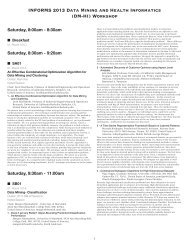
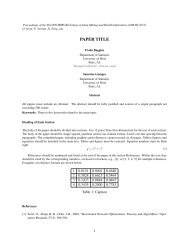
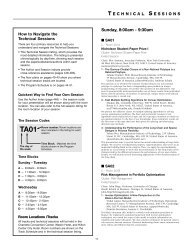
![[PDF] Charlotte Back Matter](https://img.yumpu.com/17933057/1/190x245/pdf-charlotte-back-matter.jpg?quality=85)

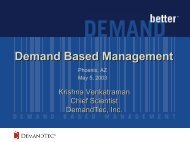
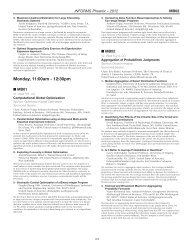
![[PDF] ALIO Back Matter](https://img.yumpu.com/17932960/1/190x245/pdf-alio-back-matter.jpg?quality=85)

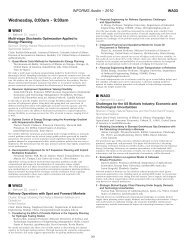
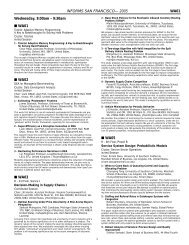
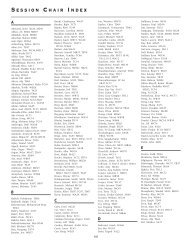
![[PDF] Monday, 8:00am - 9:30am](https://img.yumpu.com/17932954/1/190x245/pdf-monday-800am-930am.jpg?quality=85)
